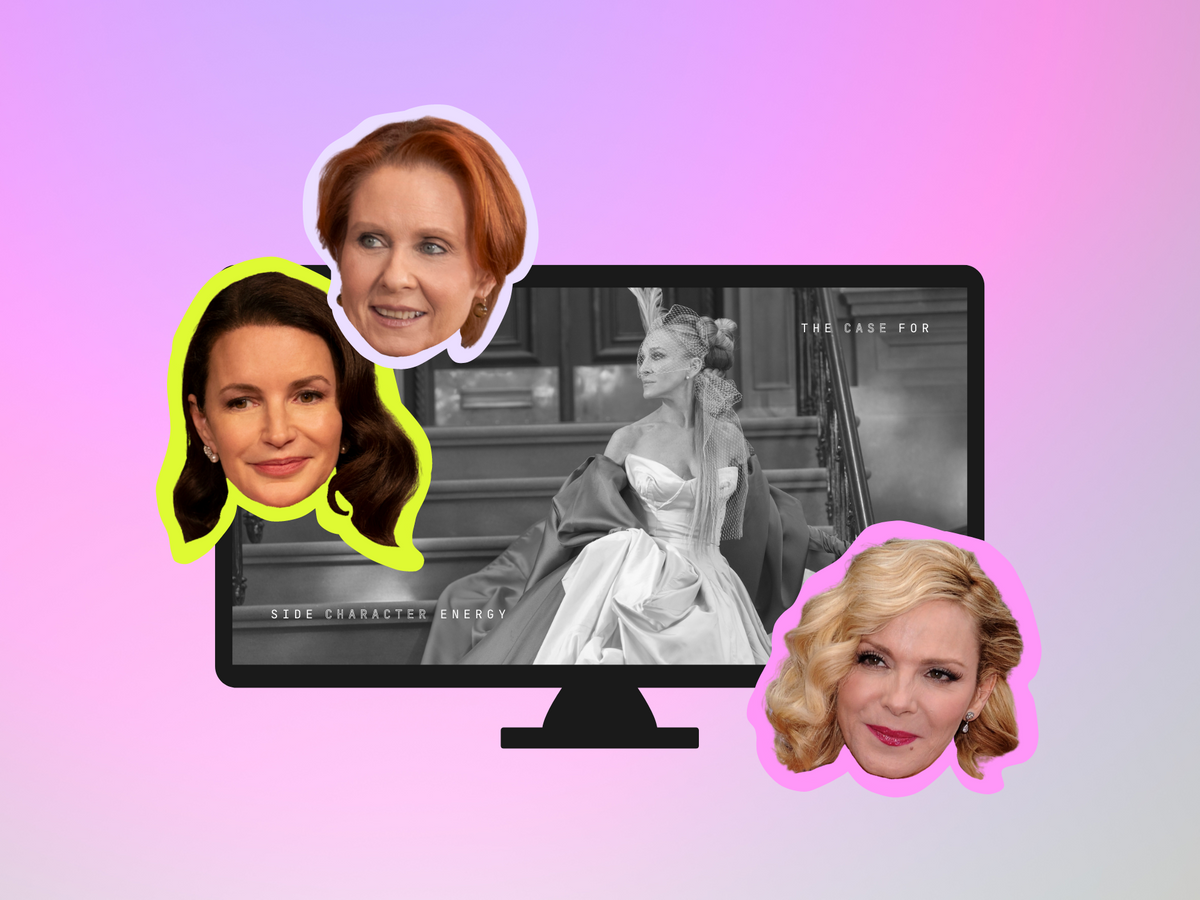Sometimes, you don't have to be in the spotlight.
The Case For Fully Embracing Side Character Energy

Olivia Taylor (she/her) is a writer, self-proclaimed reality TV buff and uses "Real Housewives" references unironically. Her camera roll is filled with Twitter screenshots and she will definitely talk your ear off for as long as you will let her. Find more of her pop culture ramblings just about anywhere on the internet.
TikTok is a destination for many things. It’s where everything from hot girl walks to spicy vodka pasta and the infamous House of Sunny knit dress lived and died amongst the constant cycle of fashion microtrends. It’s a destination where virality can (literally) change your life and escapism and romanticism run rampant. And it’s where “Main Character Syndrome” (AKA “MCS”) and “side character energy” became household phrases.
As the world emerged from a global pandemic, TikTok users turned to MCS to romanticize (or poke fun) at their own lives as a form of escapism. All of the sudden, failure became an opportunity to pivot, not an area of shame. “Side character energy” serves as a rebuttal to the aforementioned MCS — an alternative lifestyle that celebrates sharing the spotlight, if not opting out of it entirely.
Think of that scene in Nancy Meyers’s The Holiday, where the wise Arthur tells the long-suffering Iris: “In the movies we have leading ladies, and we have the best friend. You, I can tell, are a leading lady, but for some reason you’re behaving like the best friend.”
But why is behaving as the best friend inherently bad?First of all — what is “side character energy,” and where did it come from?
Before we even jump into “side character energy,” you need to understand the context behind “main character energy” (AKA Main Character Syndrome). It’s a term used to describe the Carrie Bradshaws and Regina Georges of the world. The kind of people who need you to pay attention to them. These people crave the spotlight, if nothing else then to know that people are watching. Quite simply, MCS “refers to identifying as the protagonist in your own life story,” as therapist Kate Rosenblatt said to Insider. While this characterization is not a mental health diagnosis, it’s often used to describe someone who “believes the people around them live to support them, and views themselves as the main character of their life.”
With that in mind, “side character energy” would be used to describe someone pushed to the sidelines, used to serve or bounce off of the main character. However, while the spotlight may not necessarily shine on them, they tend to be the kinds of characters viewers favor the most. Take Sex and the City’s Samantha Jones, for example. Samantha is the embodiment of “side character energy.” Some would even argue that she has such side character energy that she is the main character. She’s stylish, witty and just downright fabulous — the kind of woman who dishes out much-needed advice to the ever self-involved Carrie whilst carrying on with her own effervescent lifestyle.
There’s more to “side character energy” than just being an offshoot of “main character energy,” though. In fact, “side character energy” is preferred by many thanks to TikTok user @lolaokola. In a video posted last June, Lola decreed that she had a new outlook on life on what we can only assume is a hot girl walk: “The vibe is ‘beloved side character with great outfits and funny one-liners’. I will not undergo any character development, nor will I grow as a person,” she explains.
What’s the appeal?
For introverts who find long stints in the spotlight draining, the appeal of swooping in and enjoying the peripheral action while offering support, a sage piece of advice or a quick quip before returning to their own (probably cooler) life is pretty obvious. Side characters aren’t working on themselves for others; instead, they're crushing their career, enjoying their own company and treating themselves while their MC counterparts are working themselves into the ground.
So, why are we ditching the starring role?
After the last few years, we need a break from “character development” for a while. We're trading in our stressors for lighter responsibilities, namely looking good, being appreciated for our divine sense of humor and dishing out frankly inconsequential advice for other people’s problems. Begone, flawed love interests and bosses who “see something” in us. Save your unnecessary drama for the main characters in our lives. For now, we’re intentionally sidelining ourselves in the game of life.
It is important to note, though, that the crux of side character energy is the choice that comes with it — not being railroaded into it. "Sometimes, when we surround ourselves with rampant main characters, we can indirectly be pushed to become the supporting stars in our own lives," said Refinery 29, "which is exactly what we don't want to do." As psychotherapist Abby Rawlinson MBACP told Well + Good, “When you’re not tending to yourself, feelings of inadequacy and low self-esteem often show up.”
“There’s definitely a dance we do in healthy, balanced relationships where sometimes we step back and lift other people up,” she says. “But when we need to, we’re still able to step forward into the spotlight.”
Embracing side character energy is far from viewing yourself as less-than. It's about taking ownership of your life and understanding that life is never as serious as it seems. It's about embracing our inner confidence and living out lives without the burdens of others' opinions. And TBH, this is one lifestyle we'll happily adopt.
Stay updated on all the latest TikTok trends with Brit + Co.
Header image courtesy of Gareth Cattermole/Getty Images (Kim Catrall), Craig Blakenhorn/Max (Sarah Jessica Parker, Cynthia Nixon, Kristin Davis).
Design by Olivia Taylor.



















